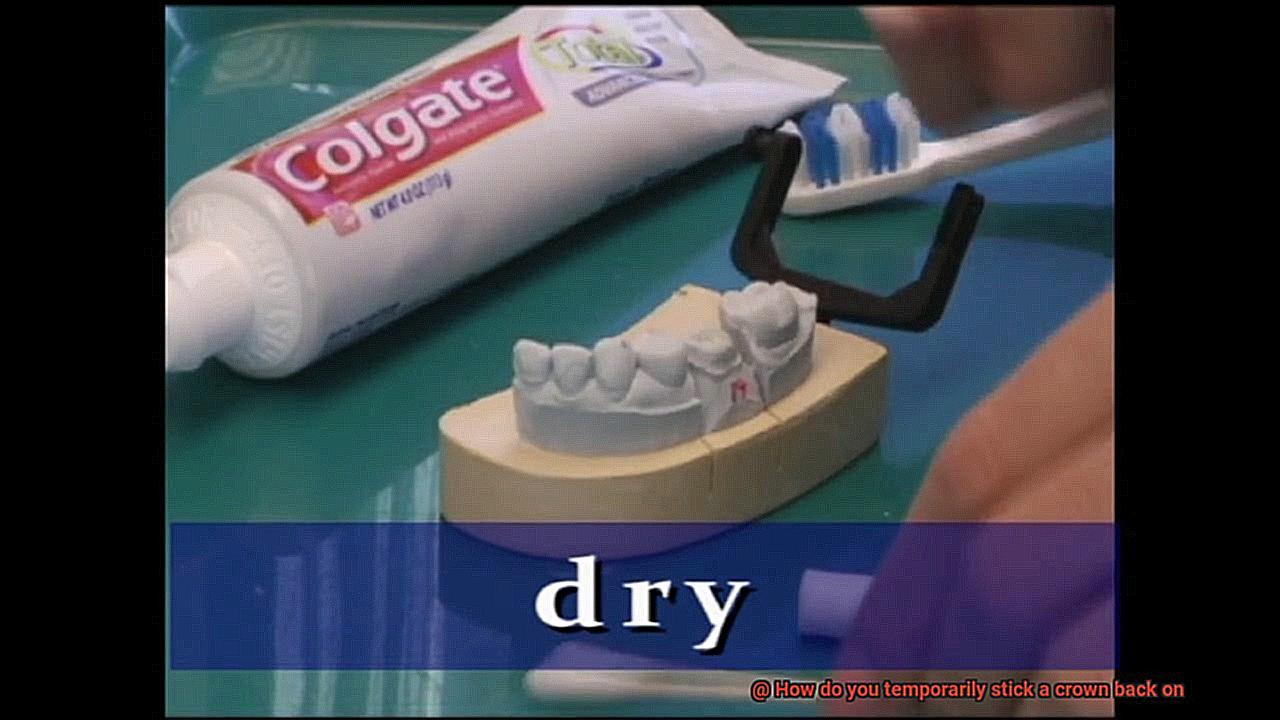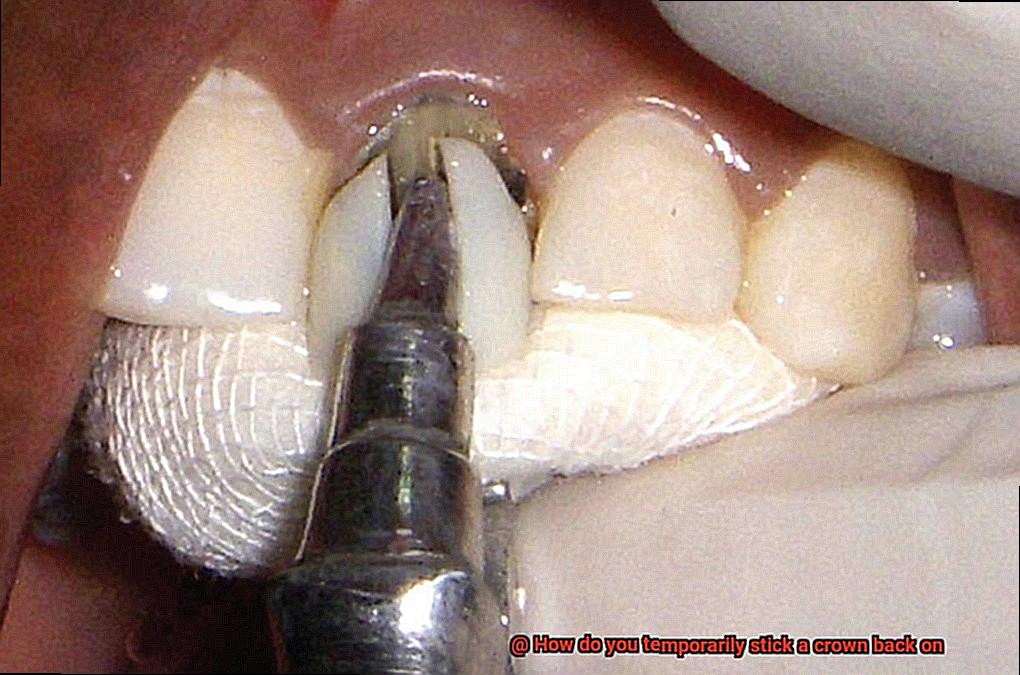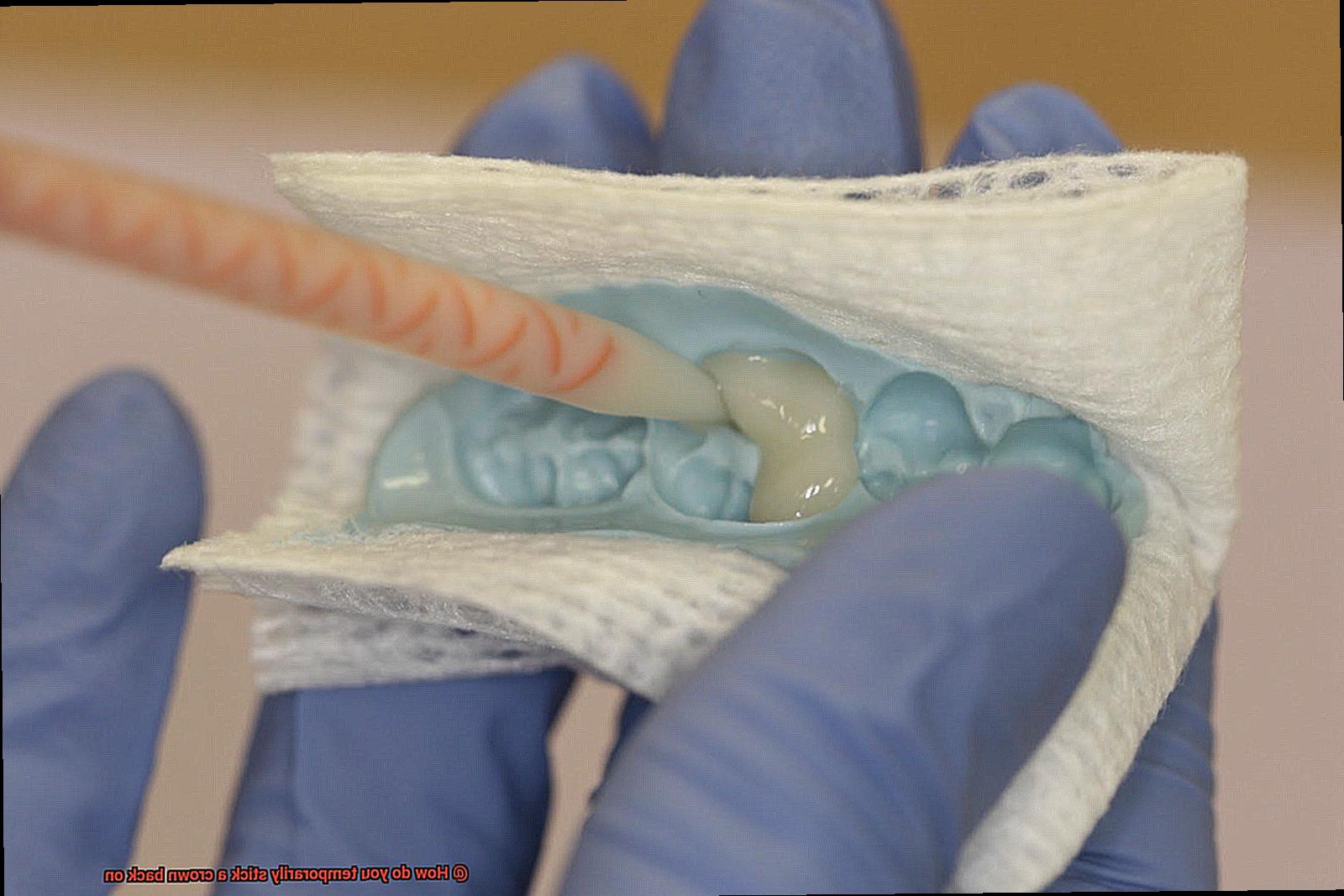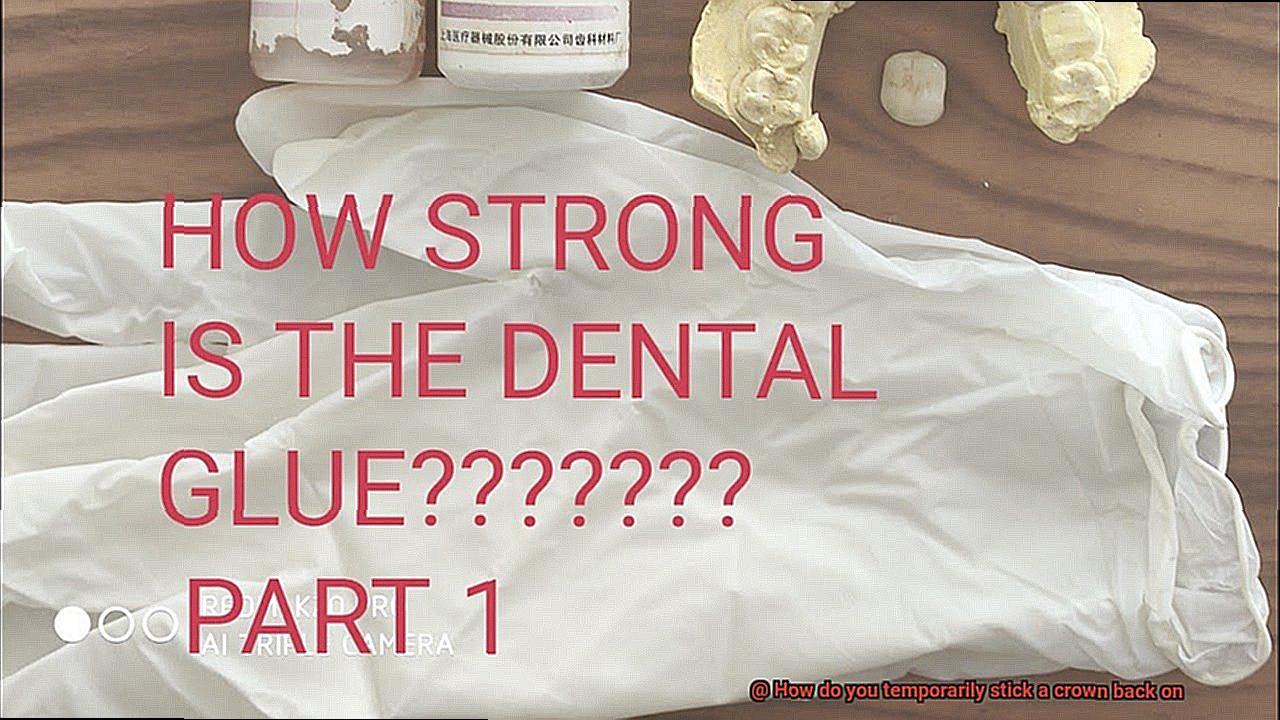Ever had that heart-stopping moment when your dental crown decides to take an unexpected vacation from your mouth? Whether it’s a result of an unfortunate encounter with a delicious meal or just the wear and tear of time, losing a crown can send anyone into panic mode.
I’m here to share a simple yet effective method to temporarily stick that pesky crown back on until you can see your dentist for a more permanent solution.
Now, before we dive into the details, let me emphasize that this is only a short-term fix. Seeking professional dental care is crucial to ensure the long-lasting functionality of your crown. But hey, let’s not waste any more time and get down to business – it’s time to reclaim that runaway crown and put it back where it belongs.
What is a Crown?
Contents
- 1 What is a Crown?
- 2 Reasons Why You Might Need to Temporarily Stick a Crown Back On
- 3 How to Clean the Tooth and Crown Before Reattaching
- 4 Option 1: Using Dental Adhesive or Temporary Dental Cement
- 5 Option 2: Using Denture Adhesive
- 6 Option 3: Using Sugarless Chewing Gum
- 7 Other Tips for Reattaching a Loose Crown
- 8 When to See a Dentist for Professional Care
- 9 Conclusion
A crown, also known as a dental cap, is a dental prosthetic that is used to restore a damaged tooth. It is made from materials such as porcelain, ceramic, metal alloys, or a combination of these materials. The primary purpose of a crown is to cover and protect a tooth that has been severely decayed, damaged, or weakened.
Crowns serve both functional and aesthetic purposes. Functionally, they provide structural support to the tooth and prevent further damage or decay. Aesthetically, they can be customized to match the color, shape, and size of the surrounding teeth, creating a natural-looking smile.
The process of placing a crown involves preparing the affected tooth by removing any decayed or damaged portions and reshaping it to create space for the crown. An impression of the prepared tooth is taken and sent to a dental laboratory where the crown is fabricated. In the meantime, a temporary crown may be placed over the prepared tooth to protect it.
Temporary crowns are not as durable as permanent crowns and require proper care to avoid damage. They are intended to be worn for a short period of time until the permanent crown is ready.
It is important to note that temporary solutions for loose crowns, such as dental adhesive, denture adhesive, or sugarless chewing gum, should only be used as temporary fixes until you can see your dentist. Professional dental care is crucial for properly reattaching or replacing a loose or dislodged crown.
Reasons Why You Might Need to Temporarily Stick a Crown Back On
In conclusion, there are several reasons why you might need to temporarily stick a crown back on. These include situations where the crown becomes loose or falls off unexpectedly, emergency situations that cause discomfort or sensitivity, the need to wait for a dental appointment, being away from home or traveling, financial considerations, esthetic reasons, preserving tooth structure, and providing psychological reassurance. However, it is important to remember that temporarily sticking a crown back on is not a permanent solution and should not replace professional dental care.
When a crown becomes loose or falls off, it can leave the underlying tooth vulnerable to further damage or decay. Temporarily sticking the crown back on can act as a protective barrier, preventing harmful substances from reaching the tooth structure. This temporary fix can help preserve the integrity of the tooth until you are able to see your dentist.
Additionally, a missing crown can impact the appearance of your smile, especially if it is a front tooth. Temporarily reattaching the crown can provide immediate esthetic improvement and maintain your confidence in your smile until you can receive proper dental care.
Moreover, temporarily sticking a crown back on can provide psychological reassurance. Losing a crown can be a stressful experience, causing anxiety and worry. By reattaching the crown temporarily, you can regain a sense of normalcy and peace of mind until you are able to seek professional dental treatment.
It is important to note that temporarily sticking a crown back on should only be done as a temporary solution. Trying to permanently fix the crown yourself could lead to further damage or complications. It is always recommended to visit your dentist as soon as possible if your crown becomes loose or falls off. Your dentist will be able to assess the situation, clean and prepare the tooth surface, and re-cement the crown using the appropriate materials for a long-lasting and secure fit.
How to Clean the Tooth and Crown Before Reattaching
To clean the tooth and crown before reattaching, it is important to follow a proper procedure to ensure a successful temporary reattachment. Here are some key steps to consider:
Gather the necessary tools
Before starting the cleaning process, make sure you have all the required tools ready. These may include a toothbrush, toothpaste, dental floss, dental pick, and mouthwash. Additionally, having a clean towel or tissue nearby will be helpful.
Remove any debris
Begin by gently brushing the tooth and crown surfaces to remove any visible debris or plaque. Use a soft-bristled toothbrush to avoid damaging the crown or the tooth structure. Be thorough but gentle in your approach.
Floss carefully
After brushing, use dental floss to clean between the teeth and around the gumline. This step is crucial as it helps remove any remaining food particles or plaque that may have accumulated in these areas.
Inspect for damage
While cleaning, take a close look at both the tooth and the crown for any signs of damage. Check if there are any cracks, chips, or fractures on either surface. If you notice any issues, it is advisable to seek professional dental care rather than attempting a temporary fix.
Rinse with mouthwash
After brushing and flossing, rinse your mouth thoroughly with an antimicrobial mouthwash. This will help kill bacteria and promote oral hygiene.
Clean the crown separately
In addition to cleaning the tooth, it is essential to clean the crown itself. Gently brush the exterior surface of the crown using a toothbrush and toothpaste. Ensure that you reach all sides and crevices of the crown to remove any debris or bacteria that may have accumulated.
Rinse again
Once both the tooth and crown are cleaned individually, rinse them well with water to remove any remaining toothpaste or mouthwash residue.
Dry the surfaces
Use a clean towel or tissue to dry both the tooth and crown. Ensuring that the surfaces are dry will help facilitate a better bond when reattaching the crown.
Remember, these steps are for temporary crown reattachment only. It is crucial to seek professional dental care as soon as possible for a permanent solution. Temporary fixes should only be considered in emergency situations and should not replace proper dental treatment.
Option 1: Using Dental Adhesive or Temporary Dental Cement
Using dental adhesive or temporary dental cement is a great option for many dental procedures. These products offer several benefits and can be used effectively in various types of dental work. Let’s explore their properties, advantages, and usage in more detail.
Dental adhesive is a specially formulated glue made from resin-based materials that provide strong adhesion. It is designed for dental use and can securely hold dental crowns, bridges, and veneers in place.
Temporary dental cement, on the other hand, is a temporary solution that can be used to hold a crown in place until a permanent solution can be implemented. Both dental adhesive and temporary dental cement are readily available over-the-counter at pharmacies or dental supply stores.
When using dental adhesive or temporary dental cement, it is important to thoroughly clean the crown and tooth before application. This ensures proper adhesion and prevents any bacteria or debris from getting trapped underneath the crown.
A small amount of adhesive or cement is then squeezed onto the inside surface of the crown. Next, the crown is carefully placed back onto the tooth and held in place for a few minutes to allow the adhesive or cement to set.
One of the key advantages of using dental adhesive or temporary dental cement is their ease of use. Patients can apply these products at home without needing to visit a dentist immediately. This provides a convenient temporary solution for individuals who experience a loose crown but are unable to see a dentist right away.
Furthermore, dental adhesive and temporary dental cement help improve oral health by preventing further damage or discomfort caused by a loose crown. By securing the crown back in place, these products restore functionality and aesthetics to the affected tooth. Patients can continue to eat, speak, and smile confidently while waiting for a permanent solution.
However, it’s important to note that dental adhesive or temporary dental cement should only be used as a short-term fix. They are not meant to permanently fix a loose crown and should be used only until a dentist can provide a permanent solution. Patients should also be mindful of their eating habits while using dental adhesive or temporary dental cement. Sticky or hard foods should be avoided as they could dislodge the crown.
Option 2: Using Denture Adhesive

Using denture adhesive as a temporary fix to reattach a crown is a convenient option that can provide immediate relief. This adhesive, specially formulated to hold dentures in place, comes in creams, powders, or strips. Let’s dive into the fascinating world of denture adhesive and explore how to use it effectively.
First things first, before applying denture adhesive, it is crucial to ensure that both the crown and tooth are thoroughly cleaned. This step guarantees proper adhesion and prevents any unwanted debris or bacteria from interfering with the bond.

Next, select the right type of denture adhesive that suits your preference. Whether you opt for the cream, powder, or strip form, be sure to follow the instructions on the packaging for optimal results.
Once you have your adhesive ready, apply a small amount onto the inner surface of the crown. Remember, a little goes a long way. Excess adhesive can cause discomfort or interfere with your bite, so use just enough to create a strong bond.
Now comes the exciting part – properly aligning the crown back onto the tooth. Take your time to ensure that it fits snugly without any gaps or misalignment. This step is crucial for a secure attachment.
To solidify the bond between the crown and tooth, apply gentle pressure. You can achieve this by biting down gently or using your finger to press down on the crown. This extra touch ensures that your temporary fix holds up well.
While using denture adhesive, it is essential to avoid indulging in hard or sticky foods. These items can exert excessive pressure on the crown, potentially weakening the adhesive bond. So, save those tempting treats for after your visit to the dentist.
Keep in mind that denture adhesive serves as a temporary solution and should not replace professional dental care. Make it a priority to schedule an appointment with your dentist as soon as possible. They will address the underlying issue and provide you with a long-term solution for your crown.
Option 3: Using Sugarless Chewing Gum
Sugarless chewing gum offers several benefits when it comes to oral health. Not only does it freshen breath and satisfy the urge to chew, but it also has some specific advantages that make it a valuable tool in maintaining a healthy smile.
One of the main benefits of sugarless chewing gum is its ability to stimulate saliva production. Saliva plays a crucial role in neutralizing acids in the mouth and washing away food particles and bacteria. By increasing saliva flow, sugarless gum helps to protect tooth enamel and prevent tooth decay.
Furthermore, sugarless gum can also help to reduce dry mouth symptoms. Dry mouth occurs when there is insufficient saliva production, which can lead to bad breath, gum disease, and tooth decay. Chewing gum stimulates the salivary glands, providing relief from dry mouth and promoting a healthier oral environment.
Another advantage of sugarless gum is its potential to help prevent cavities. Some brands of sugarless gum contain ingredients such as xylitol, which has been shown to have anti-cavity properties. Xylitol inhibits the growth of bacteria that cause tooth decay and stimulates remineralization of tooth enamel.
Additionally, chewing sugarless gum after meals can be an effective way to clean teeth when brushing is not possible. The act of chewing gum helps to loosen food particles and debris stuck between teeth, reducing the risk of plaque buildup and gum disease.

It is important to note that while sugarless chewing gum offers these benefits, it should not replace regular dental care practices such as brushing and flossing. It is a supplemental tool that can be used in conjunction with a comprehensive oral hygiene routine.
Other Tips for Reattaching a Loose Crown
In addition to using dental adhesive or temporary dental cement, there are a few other tips you can try if you find yourself in a situation where your crown becomes loose. These tips can help temporarily secure the crown until you can see your dentist for a permanent solution.
One option is to use petroleum jelly or denture adhesive as a temporary fix for a loose crown. Simply apply a small amount of petroleum jelly or denture adhesive to the inner surface of the crown and carefully place it back onto the tooth. The adhesive properties of these products can provide some temporary stability until you can seek professional help.
Another tip is to use dental wax to hold the loose crown in place. Dental wax is a soft, pliable material that can be molded and shaped to fit around the crown and tooth. It can help provide some stability and prevent the crown from moving around. However, it is important to note that dental wax is not as strong as dental adhesive or cement, so this should only be considered a temporary solution.
If you are unable to find dental wax, an alternative option could be sugarless chewing gum. Soften a small piece of sugarless gum in your mouth and carefully mold it around the loose crown. This can provide a temporary adhesive effect and help hold the crown in place until you can see your dentist.
It is important to remember that these temporary solutions should only be used as a temporary fix until you can visit your dentist. They are not meant to replace professional dental treatment, as they do not provide the same level of strength and durability as dental adhesives or cement.
It is also worth mentioning that if your crown keeps coming off repeatedly, there may be an underlying issue that needs to be addressed by your dentist. They will be able to assess the cause of the problem and provide a long-term solution to ensure the crown stays securely in place.
Lastly, it is crucial to practice good oral hygiene during this temporary period. Avoid chewing on sticky or hard foods that may put extra pressure on the loose crown. Be cautious while brushing and flossing around the crown area to prevent any further damage or displacement. Regularly rinse your mouth with a mouthwash recommended by your dentist to maintain oral health.
When to See a Dentist for Professional Care
When it comes to dealing with a loose or missing crown, knowing when to seek professional dental care is crucial. Here are some key points to consider:
- Complete loss of the crown: If your crown falls off completely, don’t hesitate – see a dentist as soon as possible. Leaving the tooth exposed can lead to further damage or infection that could have been prevented with prompt care.
- Loose but still attached crown: If your crown is loose but still attached, it’s a red flag that something isn’t right. This may indicate underlying issues with the tooth or the crown itself that need attention. Ignoring it could worsen the problem, so seeking professional care is essential.
- Pain or discomfort: Experiencing pain or discomfort in the tooth or surrounding gums is a clear sign that something is amiss. This could be due to a loose crown or other dental issues that require immediate attention from a dentist.
- Difficulty chewing or biting down: A loose crown can disrupt your ability to properly chew or bite down on food. If you notice any changes in your ability to eat, don’t delay – consult with a dentist to address the issue and restore normal function.
- Change in fit of the crown: If you feel that the crown no longer fits properly or feels different, it’s an indication of a problem. Seeking a dentist’s expertise can help determine if the crown needs adjustment or replacement to ensure optimal fit and stability.
Prompt treatment is crucial when dealing with a loose or missing crown. Dentists have the necessary tools and expertise to properly evaluate the situation and determine the best course of action for your specific case. They can assess the condition of the tooth and crown, address any underlying issues, and provide appropriate treatment for a secure and long-lasting reattachment of the crown.
Attempting DIY solutions without professional guidance can be risky and may lead to further damage or complications. It’s always best to consult with a dentist for proper care.
In some cases, a dentist may recommend replacing the crown entirely if it is damaged beyond repair or if there are concerns about its fit or stability. Trusting their judgment and following their recommendations ensures the best outcome for your oral health.
k1vHR6u15zA” >
Conclusion
When it comes to temporarily sticking a crown back on, there are a few options you can try.
One method is using dental adhesive or dental cement, which can be found at most pharmacies. Simply apply a small amount of the adhesive to the inside of the crown and carefully place it back onto your tooth.
Another option is using temporary dental cement, which is specifically designed for this purpose. This type of cement typically comes in a kit with instructions on how to use it effectively.
Additionally, you can also try using denture adhesive as a temporary fix for your crown.






